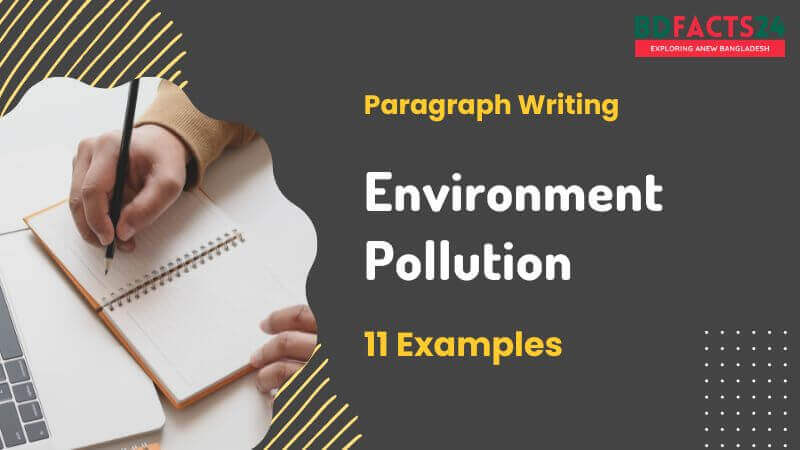Paragraph writing is an essential skill that every student must master, as it is a fundamental part of academic writing.
In this article, we will look at examples of paragraph about paragraph on “Environment Pollution” that students can reference when writing paragraphs about environment pollution, which can have harmful effects on human health and the environment.
Example 01
Bangladesh is one of the most densely populated countries in the world, and as a result, it is facing severe environmental pollution problems. Rapid industrialization, unplanned urbanization, and inadequate waste management systems are the main sources of pollution in the country.
Air pollution is a significant concern in Bangladesh, particularly in urban areas, where the concentration of harmful pollutants such as particulate matter and nitrogen oxide is high. Water pollution is also a severe problem in Bangladesh, with rivers and other water bodies being heavily contaminated by industrial and household waste. The contamination of soil by toxic chemicals and heavy metals is another major concern, affecting agricultural production and posing a threat to public health.
The government and civil society organizations are taking steps to address environmental pollution, such as promoting sustainable industrial practices, improving waste management systems, and increasing public awareness about the importance of environmental protection. However, more needs to be done to mitigate the harmful effects of pollution on the environment and human health in Bangladesh.
Example 02
Bangladesh is a densely populated country in South Asia that has been struggling with severe environmental pollution for many years. One of the biggest challenges facing the country is air pollution, particularly in the capital city of Dhaka. The high levels of traffic, industrial activity, and construction work have led to dangerous levels of air pollution, causing respiratory problems and other health issues among the population.
Similarly, water pollution is also a major concern in Bangladesh due to the discharge of untreated sewage and industrial waste into rivers and other bodies of water. This has resulted in the contamination of groundwater sources and the spread of waterborne diseases. Additionally, the improper disposal of waste has contributed to both air and land pollution, as well as the destruction of natural habitats.
To address these critical issues, the government of Bangladesh has taken several measures, including implementing stricter environmental regulations and promoting sustainable development practices. However, much more needs to be done to mitigate the impact of environmental pollution in Bangladesh and ensure a healthy future for its people and the planet.
Example 03
Bangladesh is a country that is faced with a range of environmental pollution challenges, which are having significant impacts on its people and economy. One of the most pressing environmental concerns is air pollution, which is especially severe in the urban areas. The rapid growth of industries, transportation, and construction activities has resulted in high levels of air pollution, causing respiratory illnesses and other health problems for the population.
Similarly, water pollution is also a major issue in Bangladesh, with untreated sewage and industrial effluent being discharged into water bodies. This has led to the contamination of drinking water sources and the spread of diseases such as cholera and typhoid. Another major challenge is waste management, with inadequate facilities for collection, treatment, and disposal of solid waste resulting in littering and dumping in public spaces, rivers, and canals.
Despite these challenges, there have been efforts by the government and civil society to address these issues through policy interventions, awareness-raising campaigns, and community-based initiatives. However, much more needs to be done to ensure a healthy environment for the present and future generations of Bangladesh.
Example 04
Bangladesh is a country facing a unique set of environmental challenges due to its geographical location and socio-economic conditions. The country is located in the delta region of the Ganges-Brahmaputra-Meghna river system, which makes it vulnerable to natural disasters such as floods and cyclones. These disasters have a significant impact on the environment, leading to soil erosion, deforestation, and loss of biodiversity.
Additionally, Bangladesh is experiencing rapid industrialization and urbanization, which is putting a severe strain on its natural resources and causing environmental pollution. Air pollution, caused by vehicular emissions, industrial activities, and brick kilns, is a significant concern, especially in cities like Dhaka. Water pollution is another significant problem, with the contamination of rivers, lakes, and groundwater by industrial waste, sewage, and agrochemicals.
Moreover, the country’s agricultural practices, such as the overuse of fertilizers and pesticides, are contributing to soil pollution, which is affecting crop production and public health. Despite the government’s efforts to mitigate the harmful effects of environmental pollution, much needs to be done to ensure a sustainable future for Bangladesh. The country needs to adopt more eco-friendly and sustainable practices and invest in green technologies to minimize the impact of pollution on the environment and human health.
Example 05
Bangladesh, a populous country in South Asia, is facing severe environmental pollution challenges that are impacting the health and well-being of its citizens. One of the most significant issues is air pollution, caused by industrial activities, transport emissions, and burning of biomass fuels. The high levels of pollutants have been linked to respiratory diseases, cancer, and premature death.
Similarly, water pollution is a major problem, with untreated waste and chemical discharges from industries contaminating rivers, lakes, and groundwater sources. This has led to water shortages, crop damage, and increased incidence of waterborne diseases such as diarrhea and dysentery. Additionally, waste management practices in Bangladesh are inadequate, leading to the accumulation of garbage on streets and public spaces. This not only pollutes the environment but also poses a risk to public health through the spread of diseases.
Despite these challenges, there are initiatives being undertaken by both the government and civil society organizations to address these problems, such as promoting renewable energy, enforcing stricter regulations for industrial effluent discharge, and encouraging responsible waste disposal practices. However, more action is needed to mitigate environmental pollution in Bangladesh and ensure sustainable development for the future.
Example 06
Bangladesh is a country with a rich natural heritage, but environmental pollution is posing a significant threat to its ecosystems and the health and well-being of its people. The country’s growing population and rapid industrialization have led to an increase in air, water, and soil pollution.
Air pollution is a particular concern, with high levels of particulate matter, nitrogen oxide, and sulfur dioxide causing respiratory problems and other health issues. Water pollution is also widespread, with untreated industrial and household waste contaminating rivers, lakes, and groundwater sources. Soil pollution is another problem, with the overuse of agrochemicals and industrial waste damaging the fertility of the soil and posing a threat to food security. The government of Bangladesh has taken some steps to address environmental pollution, such as banning plastic bags and promoting renewable energy.
However, more needs to be done to reduce the country’s reliance on fossil fuels and to promote sustainable development practices that balance economic growth with environmental protection. Additionally, public awareness and participation are crucial in the fight against environmental pollution in Bangladesh. Educating the public on the importance of reducing waste, conserving natural resources, and adopting eco-friendly practices is key to achieving a sustainable future for Bangladesh.
Example 07
Bangladesh is a country that is facing complex environmental pollution problems, which are threatening the health of its people and ecosystems. Air pollution has become a significant concern in urban areas, particularly in Dhaka, with the increasing use of fossil fuels, vehicular emissions, and industrial activities. This has led to respiratory illnesses, heart disease, and even premature death among the population.
Water pollution is also an alarming issue, with the disposal of untreated waste and hazardous chemicals from the textile industry being dumped into rivers, causing contamination of both surface and groundwater sources. This pollution not only affects human health but also harms aquatic life and the environment. Moreover, inadequate waste management systems have resulted in unsanitary conditions in many areas, including streets and waterways, leading to risks of disease outbreaks.
Despite these challenges, there are efforts being made to mitigate the impact of environmental pollution in Bangladesh. The government has introduced policies aimed at reducing air and water pollution, promoting clean energy, and encouraging sustainable development practices. Civil society groups are also taking initiatives to raise awareness and promote innovative solutions. However, much more needs to be done to create a healthy and sustainable environment for the people of Bangladesh.
Example 08
Environmental pollution is a growing concern in Bangladesh, a densely populated country that is still in the process of industrialization. The combination of rapid urbanization, industrial growth, and weak environmental regulations has led to significant environmental degradation in the country. Air pollution is a major issue, particularly in the urban areas, where vehicular emissions, industrial activities, and brick kilns contribute to high levels of particulate matter and other pollutants.
Water pollution is also a significant problem, with rivers and other water bodies heavily contaminated by industrial waste and sewage. Soil pollution, caused by the overuse of agrochemicals and industrial waste, is affecting agricultural productivity and posing a risk to public health. Climate change is another significant threat, with rising sea levels and extreme weather events affecting the country’s coastal regions. The government of Bangladesh has taken steps to address environmental pollution, such as improving waste management systems and promoting renewable energy.
However, much more needs to be done to achieve a sustainable future for Bangladesh. This includes stricter enforcement of environmental regulations, promotion of eco-friendly practices, and public awareness campaigns to educate people about the importance of environmental protection. The collaboration between the government, private sector, civil society, and individuals is crucial in the fight against environmental pollution in Bangladesh.
Example 09
Bangladesh is a country that is facing severe environmental pollution issues due to its rapidly growing population and developing economy. Air pollution is a significant concern, with emissions from transportation, industrial activities, and brick kilns contributing to high levels of particulate matter and other pollutants in the air. Water pollution is also a critical problem, with untreated industrial and domestic waste contaminating rivers and other water bodies.
Moreover, soil pollution caused by the overuse of agrochemicals and the disposal of industrial waste is affecting agricultural productivity and posing a threat to public health. The impact of climate change is another significant concern, with rising sea levels and extreme weather events putting millions of people at risk. Despite the government’s efforts to address environmental pollution, including the introduction of stricter environmental regulations, the situation in Bangladesh remains a daunting challenge.
More needs to be done to promote sustainable development, encourage the use of eco-friendly technologies and practices, and increase public awareness about environmental protection. It is vital that Bangladesh moves towards a more sustainable future to ensure a healthy environment and a better quality of life for its people.
Example 10
Bangladesh is one of the most densely populated countries in the world, and unfortunately, it also suffers from severe environmental pollution. The country faces a range of environmental challenges such as air pollution, water pollution, and soil degradation. The rapid industrialization and urbanization have contributed significantly to this problem.
For instance, the transportation sector releases a considerable amount of pollutants into the atmosphere, causing severe respiratory problems for the population. Additionally, untreated industrial effluents are discharged into rivers and other waterways, leading to water pollution and affecting aquatic life. Furthermore, agricultural practices that use excessive amounts of pesticides and fertilizers have led to soil degradation and contaminated food products.
The government has taken some steps towards addressing these issues, but problems still persist due to a lack of proper implementation and enforcement of regulations. Bangladesh must adopt sustainable development practices to ensure the health and wellbeing of its citizens and preserve its natural resources for future generations.














